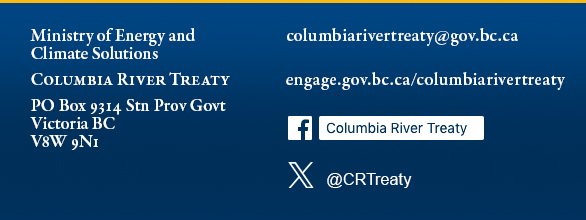Columbia River Treaty
Edition: December 2024

Interim Agreements to Bridge the Gap
Dec 18, 2024
Revelstoke Railroad Bridge across the Columbia River at Revelstoke, B.C.
While the Agreement-in-Principle (AIP) is a key step forward towards modernizing the Columbia River Treaty, it is not a legally binding document. Until a modernized Treaty has been finalized and brought into force by both countries, the current Treaty remains in place.
To bridge the gap between the AIP and a modernized Treaty, the Canadian Entity (BC Hydro) and U.S. Entity (U.S. Army Corps of Engineers and Bonneville Power Administration) have entered into interim arrangements under the existing Treaty through exchanges of diplomatic notes between Canada and the U.S. to allow continued operations and implement some components of the AIP.
These arrangements will ensure:
- the Canadian Entitlement set out in the AIP will continue until 2044, securing predictable benefits to B.C. over the next two decades; and
- the pre-planned flood risk management operations as outlined in the AIP are implemented for a three-year period and ensure that B.C. is compensated as set out in the AIP.
Those interested in reading the agreements can find them on the B.C. Columbia River Treaty website.
The interim flood risk management agreement is of particular interest to many people in the Basin. The original Treaty required that Canada/B.C. operate with 8.95 million acre feet of reserved space in its Treaty reservoirs to provide flood risk management to the United States. That provision expired in September of this year and moved to a more ad hoc “Called Upon” regime, requiring the U.S. to draft their reservoirs more deeply and frequently to manage flood risk, before “calling upon” Canada for additional storage to prevent flooding.
In Canada and the United States’ negotiations to modernize the Treaty, the countries reached an agreement, in principle, on a reduced level of pre-planned flood risk management storage in B.C. reservoirs, securing more operational certainty on both sides of the border while reducing the amount of storage volume Canada/B.C. would need to provide down to 3.6 million acre feet. The new interim agreement on pre-planned flood risk management reflects this reduced storage amount.
Earlier in December, the U.S. Army Corps of Engineers and Bureau of Reclamation held two webinars to explain the potential changes to river flows and reservoir storage in the U.S. under the new new flood risk management dynamic. This includes the need for the U.S. to utilize their reservoir space to manage flood risk more than they have under the original Treaty. The recording is available for those interested.
Canada, B.C. and Basin First Nations are continuing to work collaboratively with the U.S. to draft the modernized Treaty text towards ratification by both countries. If a modernized Treaty is ratified before these interim agreements expire, the modernized Treaty will take precedence.



